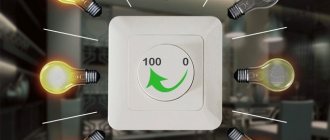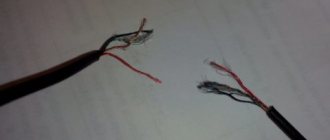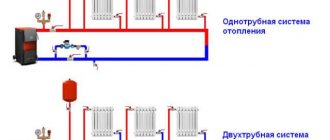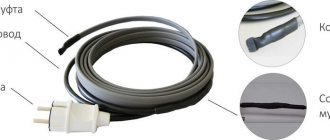Ventilation in a bathroom or other poorly ventilated room ensures a comfortable stay for a person by supplying and removing polluted air. A fan timer adds convenience - a device that turns the hood on and off. In this article you will learn how to connect a fan with a timer correctly.
- The need to install a domestic fan
- Reasons for installing it
- The best places to install an exhaust fan in the house
- Types of fans for domestic use
- Requirements for exhaust equipment in the bathroom
- Calculation of productivity using the formula
- Modern additional devices
- Location of ventilation ducts
- Bathroom ventilation
- Recommendations from engineers when choosing bathroom ventilation
- How to install a fan in the bathroom
- The principle of connecting to the electrical network
- Control by turning the lighting on/off
- Why do you need a timer for a bathroom fan?
- Connecting a bathroom timer
- Wiring diagram in the bathroom for a fan with a timer
- Bathroom timer connection diagram
- Connection via switch
- How to connect an exhaust fan to a switch
- Ventilation for toilet
- How to connect a fan in the toilet
- Types of fans with sensors
- Fan without built-in timer
- Fan with built-in timer
- Device with built-in humidity sensor
- DIY installation instructions
- Preparatory work
- Required tools and materials
- Connection methods
- Connection diagram and connection of wires in the distribution box
- Connect directly
- Connection via one-key switch
- Connection via two-button switch
- Electrical diagram for connecting a fan from a two-key switch
- Fan with built-in switch
- Combined connection of fan and lighting via a single-key switch
- Connection errors
- How not to connect and why
- How to avoid common mistakes
Whether the unit is needed or not can be answered unequivocally – it is needed!
How does the device work?
If the bathroom lights are turned off, the hood fan will also be turned off. In this case, the current consumption will be minimal, which will not even be recorded by electricity meters. This is the so-called standby mode.
When you turn on the lighting in the bathroom, the timer begins counting the period of time before turning on the hood, which lasts approximately 15 seconds (deviations by 1-2 seconds are possible). If you manage to turn off the light before this time is up, the fan will not turn on at all. For example, a person entered the bathroom to put or take something, which took a matter of seconds, but the hood would not turn on. This is very convenient because there is no need for the hood to operate. When the light is on for more than 15 seconds, the timer will turn on the hood fan, and it will work as long as the light is on and after it is turned off for 5 minutes. In addition, for every 2 minutes the light is on, the fan operating time after turning off is extended by another 1 minute. After turning off the light, the hood can operate for a maximum of 30 minutes. For example, if a person went into the bathroom and turned on the light, after which he stayed there for 15 minutes (took a shower or bath), then the operating time of the hood after turning off the light will be 13 minutes (5 minutes + 15 minutes/2 = 13 minutes).
The fan timer also provides the following program: after the light is turned off, the fan operating time will be the same as it worked when the light was on. Different timer fan models may have different operating intervals.
If the fan is running and the light in the bathroom is turned on again, then the duration of the fan operation will be determined as the sum of the remaining time that has not yet ended and a new period of time, which can be calculated using the described method.
The LED flashes every second to indicate that the device is operational and ready for use.
Devices with light sensors
There are also timers with light sensors that react specifically to the presence of lighting. They no longer need the command wire from the lamp.
As a rule, the exhaust fan is mounted under the ceiling in the wall of the bathroom, so that when the lights are turned on, it will be as brightly illuminated as possible. For the timer to work correctly, there must be a significant difference when the bathroom lighting is on and off. If the bathroom is so light that the hood does not stop working, you need to paint over the LED with varnish to reduce the amount of light or deepen it.
It should be remembered that the timer elements are live, which is why you need to be extremely careful when installing the device or when testing it. The danger increases because the installation is carried out in a room where the risk of electric shock is high due to humidity.
Design and operating rules
The timer is a single-sided printed circuit board on which the elements are mounted. Component DD1 is connected on the conductor side, the remaining components are installed on the other side.
To protect the printed circuit board from moisture, it is recommended to open it with moisture-resistant varnish.
The most common type of timer is connected to a 220 V network and has a signal wire input from a lighting lamp. In other words, the timer is always connected to power, and the fan is already connected to it. When you turn on the light in the bathroom, a signal is sent to the timer and the time begins counting down, after which the hood turns on. When the light is turned off, the power on the signal wire disappears and the countdown begins until it turns off.
Fan connection diagrams
How can you implement the wiring diagram for a fan with a timer from Era or any other manufacturer? It’s worth noting right away that you don’t have to entrust such work to specialists; you can do everything yourself. At the same time, installing the device itself is not a problem, and that’s only half the battle. The main thing is to apply voltage to it. And since we are considering fans that are equipped with a timer, there are not many options:
- Connection via a switch - that is, parallel to the lighting.
- Connection directly to the distribution box - a fully automated system without human intervention.
It is worth noting that all these options are best implemented at the stage of renovation or construction of a new facility. Then the wires will be securely hidden under the tiles or plaster. Otherwise it presents certain difficulties.
Fan characteristics
It is impossible to choose the right fan with a timer without knowing its basic characteristics. Therefore, before purchasing, it is recommended to pay attention to the parameters that affect the operating efficiency and durability of the equipment.
Performance level. In order to determine the required power of the device, you should calculate the volume of the room and multiply the result by eight. The resulting value is the minimum performance of the device.
Presence of extraneous noise and acceptable standards. Devices with and without noise absorbers are available for sale. The noise level that the fan creates during the operating process is indicated in the device passport.
If the value indicated in the documents is higher than 35 dB, such a device is not worth buying.
Control method. Timers may differ in the principle of entering the necessary parameters: buttons, rotary mechanical relay or remote control. Users must independently choose the most suitable option for themselves.
The presence of a humidity sensor. Not all devices are equipped with this option. But its presence allows you to adjust the operation of the fan depending on the humidity in the room.
Fans with a timer are a good solution
We have already become familiar with the need for a forced ventilation system - it is enough to install an exhaust device. However, in comparison with conventional models, analogues with a clock device have much greater advantages. By implementing in practice the connection diagram for a fan with a timer, you can bring the ventilation to almost ideal.
First of all, we are talking about saving electrical energy. The fan, which is powered in parallel with the lighting, will turn on even when the owner simply goes into the bathroom to wash his hands or load dirty laundry into the washing machine. That is, the device starts working even if there is no need for air exchange.
The operation of models with a timer is due to a long stay in the bathroom and in this case it is no longer possible to do without air circulation. As a result, the fan functions, as they say, strictly to the point.
No draft!
Here lies another compelling argument in favor of installing a fan with a timer. When taking a bath or shower, a person is not exposed to a draft. After all, the device will turn on after the owner leaves the room. As a result, the risk of catching a cold during water procedures is minimal, if not completely absent.
The wiring diagram for a fan with a timer in the bathroom itself should not raise any questions. The presence of additional ventilation after the process allows you to remove all condensation from the walls. And the last reason: with models equipped with a timer, you don’t have to worry about turning them on and off. Actually, the clock device itself takes on all the responsibilities for turning the fan on and off. All you need is to set the required period of its operation once.
Option - manual switching on, switching off delay
Here you will need a special fan with a built-in timer. On average, it is about 500 rubles more expensive than usual. You need to place a button on the wall (monostable switch), pressing which will turn on the fan for a specified time. That is, we can turn on the hood ourselves when we need it. You need to provide this button in advance and put some clear pictogram on it, but the fan will not make noise when it is not needed.
If you take a slightly more advanced fan with a humidity sensor, it will automatically turn on when the humidity rises, that is, when someone uses the shower.
By the way, I have implemented this option at home. I personally find it the most convenient.
Features of the right choice
When using a fan connection diagram with a timer in a bathroom or toilet, the choice of the device itself is also of considerable importance. To do this, you must first pay attention to its main characteristics:
- performance;
- electrical safety;
- noise level.
The performance of the appliance is largely determined by the volume of the bathroom, including the number of people using it. To calculate this parameter, you need to remember one formula, well known from school: multiply three quantities together: length, width and height.
After this, the obtained result must be multiplied by the frequency of ventilation. According to SNiP, this figure for a family of three is 6, for a larger number of people it is 8. The number will ultimately be the fan’s performance. In this case, it is better to choose a device with a value slightly larger than the calculations obtained.
In the connection diagram for a fan with a Vents timer, for example, the degree of electrical safety is no less important than performance, if not more. And since the device must operate in a room with a high level of humidity, then this indicator should vary from IPX3 to IPX5. This indicates that the device body is reliably protected from splashes and moisture, including direct contact with a jet of water. It is not worth purchasing one of the options with a higher protection class for a bathroom in an apartment or private house due to its inexpediency. This is not an industrial premises.
Regarding the noise level, there is only one condition: the quieter the fan is, the better. That is, you should choose those models whose operating volume is no more than 30 dB. This is especially true if it is necessary to carry out ventilation at night.
Types of fans for domestic use
The equipment is available in two varieties: built-in and separately located. The most common activation is by pressing a switch. Automatic electrical appliances are equipped with electronics that simplify and control operation.
Additional features are:
- on/off timer;
- lighting in different colors;
- humidity sensor.
The device turns on when the permissible humidity level is exceeded and turns off when this value returns to normal. By design, hoods can be radial (centrifugal) and axial, ceiling-mounted and wall-mounted, with or without blades.
Requirements for exhaust equipment in the bathroom
In accordance with regulatory documents, in order to create normal air exchange, you need to adhere to the following indicators:
- 8-10 sq.m/h. per 1 cu. for a combined bathroom;
- 6-8 sq.m/h. - For bathroom.
The volume of exhaust air from these rooms is more than 30 cubic meters per hour. The permissible norm is 30 dB - if higher, then for people this sound will be too loud and annoying.
Calculation of productivity using the formula
Before purchasing equipment that is optimal for productivity, calculations are necessary. First you need to calculate the volume of the room (height multiplied by area), which is multiplied by the aeration rate.
Attention! The maximum air exchange value in rooms with high humidity is approximately 10.
Example: a room has an area of 8 m3, a height of 2.5 m, resulting in a volume of 20 m3. The resulting number is multiplied by 6...8, resulting in 120...160 m3/h. Therefore, for a room of 8 m3, equipment with a capacity of 120...160 m3/h is required.
Modern additional devices
Modern additional functions increase the power of the hood. It increases by a maximum of 10%. The most popular electrical appliances are those that operate economically and silently - their power varies from 7 to 18 W. If the power indicator is too high, then a draft and noise of air flow is created.
Location of ventilation ducts
It is easy to install the unit if the shaft is located directly behind the wall of the bathroom, even if it is combined with a toilet or is located next to the kitchen. If these two rooms are separated, then a channel design is required. It is installed on a shaft segment, at the junction of 2 air ducts.
Reasons for installing a fan
The main sign that indicates the need to install a fan in the ventilation duct is the appearance of condensation and, as a result, mold and mildew on various surfaces of the room. These pathogenic microorganisms can serve as a source of various types of infections that affect residents of an apartment or private country house. In addition, the premises of an apartment or house can be filled with odors from neighbors below or above. This also suggests that natural ventilation is not working well.
The use of a connection diagram for an extractor hood fan with a timer in the bathroom helps improve the sanitary environment of the room. When the device is turned on, the air mass circulates, which leads to the disappearance of unpleasant odors. On metal surfaces (again due to the high level of humidity), the appearance of new rust is stopped.
As for the proliferation of fungi, their growth also stops. In addition, damp deposits on tiles (and such material is present in the design of many bathrooms) and mirrors disappear.
There are different models of fans on sale, among which you can find modern devices that operate silently. In addition, they have a rather attractive design and compact size.
Why ventilate your bathroom?
Connection instructions
The bathroom often has a small area, so without constant air circulation the humidity level will be very high. This will promote the appearance of fungus, mold and other microorganisms. In addition, the service life of many building materials used in furnishing the premises may be significantly reduced. Since the bathroom does not have windows, the only way to maintain normal humidity is to use installed ventilation systems. They are usually designed to maintain air circulation without additional devices. You can check if this is enough by placing a sheet of thin paper against the hole and releasing it. It must be held due to the difference in pressure inside and outside and not give in. If this does not happen, you need a fan that will provide forced air circulation and lower the humidity level.
Wiring diagram in the bathroom for a fan with a timer
As you can see, you need to run a three-wire cable to the exhaust fan.
Now, knowing the connection diagram, you can proceed directly to installation.
Option - delayed shutdown
This is an evolution of option 2, and quite significant. Let's look at the control units for the exhaust fan from Noolight (Belarus).
The BZT-300-SU unit is connected to a 230V power supply, an exhaust fan (to control it) and a bathroom lighting (to understand when it turns on). The timer turns on the fan 30 seconds after the lights are turned on and turns off the fan 5 minutes after the lights turn off. Not bad already. If we logged in for less than 30 seconds, then we won’t hear it. And 5 minutes of work will be enough for ventilation.
The BZT-300-SUF block is even cooler. There is no need to connect a lamp to it; it has a built-in photocell that will understand when the light turns on. And the turn-on delay and turn-off delay times are adjusted with knobs on the block, as is the sensitivity of the light sensor. The block costs about 500 rubles, but greatly adds comfort.
Installation stage
With the diagram for connecting a fan with a timer to the electrical line, everything is now more or less clear; now it’s time to get down to the installation procedure. However, an electrical cable must first be laid to this place. To do this, a groove is made from the distribution box.
Now it is clear why such work is planned to be done during scheduled repairs or during the construction stage. After this, you should connect the wires to the contacts on the fan (this has already been written in more detail above).
Before installing the fan, the decorative grille is removed from the shaft channel (if it has been cleaned, it is already open). If you chose the installation method using self-tapping screws, you should drill holes for the dowels, where they will then be screwed in during the installation of the fan. At this point, the dowels themselves should already be pre-inserted into the holes made.
If necessary (if it is not possible to fasten it with self-tapping screws), you can go the other way - attach the body of the exhaust device to a special glue or sealant. At the final stage, the removed decorative panel is returned to its place.
Installation of equipment
Household fans can be divided into 2 categories:
- wall;
- duct.
The wall mounted unit is placed directly in front of the vent outlet. If there is a need to move the device away from the hole (for example, when installing in a bathroom with a suspended ceiling), you can run an air duct to connect the fan and the shaft. The duct structure can be installed in the gap above the suspended ceiling.
The second type of fans can only be mounted inside the ventilation duct. They are usually used when carrying out work together with a suspended ceiling and are installed inside the air duct. Their body can be round or rectangular. You need to choose one that will match the shape of the air duct being installed. A diffuser is installed at the outlet. It can be used to regulate the air flow.
The height for mounting the device must be selected as high as possible. The top edge should be 50 mm below the ceiling. If the ventilation hole is located significantly lower, it is recommended to move it. Fastening is carried out using self-tapping screws or liquid nails. The choice depends on the weight of the device and the material of the walls.
Connect directly to the junction box
Fans with a humidity or motion sensor allow you to make air exchange in the bathroom fully automated (they are in any case equipped with a timer). That is, the participation of the home owner is not necessary at all. Even in a simple connection diagram, a fan with a timer and a humidity sensor should not include the cheapest one. In addition, you should pay attention to another point if the bathroom is separate:
- Devices with a humidity level sensor - for the bathroom.
- Fans equipped with a motion sensor – for the toilet.
The first ones will be activated automatically, as soon as the humidity level exceeds the established limits. Moreover, the hood will work until it reaches the normal parameters.
As for models with motion sensors, they are turned on when a person appears in the range of the sensors. The fans will automatically turn off after the delay set on the timer.
And since the system is fully automated and operates without human intervention, switches are not included in its connection diagram as unnecessary. For this purpose, the wires from the distribution box (phase, neutral, ground) go directly to the fan contacts.
Connecting a bathroom timer
As an example of connection, we use the popular Granit-BZT-300-SU timer from the Nootekhnika company. It will work in tandem with an S&P Silent 100 exhaust fan.
The device itself is quite compact, you can see it in the image below. The maximum power of the fan connected to it should not exceed 300W.
As you can see, the timer has six contacts for connection, all of which are used during installation. And although it looks quite scary, there is nothing complicated here, especially if you understand the connection diagram.
Natural ventilation analysis
However, before you start creating a forced ventilation system, it is worth analyzing the natural one. First you need to find the shaft hole and remove the decorative panel. Over the many years of operation of the building, usually no one looks here due to lack of need (according to the residents). Therefore, you can find not only deposits of garbage and dust there, but even cobwebs.
In accordance with SNiP, air exchange parameters in a standard bathroom should be 25 m3 per hour. Therefore, when designing it, it is difficult to do without a connection diagram for an exhaust fan with a timer. Of course, in the absence of special equipment, it is impossible to determine compliance with this standard. At the same time, you can use one folk method.
After the channel is put in order, it is worth bringing a lit match, candle or lighter to it. If the flame deviates towards the shaft, then the ventilation is functioning properly. And in this case, the decision to install a fan can be made for preventive purposes, or this measure can be abandoned for now.
If this technique is not enough for someone, you can use another one - using a sheet of paper. To do this, take a small piece and lean it against the ventilation shaft:
- the leaf is holding - everything is fine;
- a piece of paper fell to the floor - conclusions in favor of installing a fan.
The connection diagram for a fan with a timer in the bathroom will be implemented at its best if there is a flow of fresh air in the room. As a rule, its circulation is achieved through a small gap under the door. It is for this reason that a threshold is not installed in this room.
The need to install a domestic fan
Why him? In residential and public premises, a ventilation system is installed that operates due to fresh air inflows, but sometimes the existing exhaust design is not enough. Installation of active ventilation systems does not allow the concentration of carbon monoxide, unpleasant odors or humidity in the room. Which guarantees to avoid all negative consequences.
Reasons for installing it
Over time, the channels become dirty and cannot fully cope with their function. This is easy to determine:
- Condensation appears on walls, ceilings, objects, plumbing fixtures;
- mirror surfaces become cloudy;
- the finish deteriorates;
- The unpleasant odor does not disappear for a long time.
If at least one of the signs becomes noticeable, you need to connect the hood. It will avoid stagnation of air masses, unpleasant odors, mold, dampness and fungal formations. With proper operation, the room will have a healthy microclimate, condensation will not appear, finishing materials and furniture will retain their original appearance. You can purchase a fan with a timer or install one yourself.
Connection diagram for a fan with a timer from a light bulb
Exhaust fans with a timer are more expensive than conventional analogues without additional equipment. However, this is a good option for use in a bathroom. In this case, the connection diagram implies the presence of a switch and looks like this. Here you will need 4 wires:
- The phase wire goes to contact L directly from the junction box.
- Contact Lt - also for supplying the phase, only through the light switch.
- Terminal N - corresponds to zero; a wire also goes directly to it from the junction box.
- The PEN contact is a ground connection for connecting the corresponding conductor.
In other words, only the phase is opened, as is the case with lighting.
With this scheme for connecting a fan with a timer, the operating algorithm is as follows. Turning on occurs simultaneously with the lighting, and turning off occurs after a certain time after turning off the light (configurable on the device). That is, the fan will work even if the owner has already left the room. Usually this is a period from 5 to 30 minutes, which is quite enough for flow ventilation.
But there are other models on sale that are equipped with a reverse mode. In other words, the fan motor will only work when the light is turned off, that is, the opposite of the first option. And then after the time set by the timer has expired.
Differences in Operating Principles
Different types differ in price and technical characteristics: noise level, power. Fans for domestic use can be divided into 3 types:
- axial;
- diametrical;
- radial;
The use of cross-flow exhaust fans is usually not required in this case. It is enough to choose between radial and axial.
Axial
Appearance of an axial fan
The most budget option, which also usually has greater performance. However, the noise level can be significantly higher than that of radial ones. It is recommended to choose it if the bathroom has a large area.
The device consists of an electric motor and an impeller with blades attached to it. The principle of operation is as follows: the engine rotates the wheel, air is captured by the blades and directed into the ventilation channel. If the device is equipped with a check valve, the flow of air from the ventilation into the bathroom becomes impossible, which allows protection from dust, harmful microorganisms and insects.
Radial
Appearance of a radial fan
It consists of a wheel located in a spiral casing. Through the holes between the blades, air enters the device, then is compressed and passes into the spiral casing, and then into the heating hole. The performance of budget devices is quite low.
Option - even simpler
What could be even simpler than a hood switch? Turning on the hood along with the bathroom light. It makes sense in a frequently visited public toilet, where the fan does not disturb anyone with its operation. In an apartment, this means that, firstly, the fan will turn on and make noise every time, secondly, in most cases it will turn on when it is not needed, thirdly, turning off along with the light, it will not perform its function, that is, it will not have time to draw out the air so that it can be renewed from other rooms.
Sources
- https://mr-build.ru/ventilyatciya/tajmer-ventilyatora-sanuzla.html
- https://FB.ru/article/463323/shema-podklyucheniya-ventilyatora-s-taymerom-printsip-rabotyi-i-poryadok-soedineniya
- https://home-matic.ru/2017/06/umnoe-upravlenie-vytyazhkami-sanuzlov/
- https://rozetka-online.ru/podkljuchenie-i-ustanovka/item/144-podklyuchenie-tajmera-vytyazhnogo-ventilyatora-v-sanuzle
[collapse]











